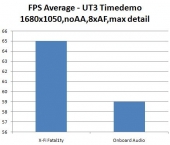Testing
Testing was conducted with the following setup:
CPU: AMD Phenom II X4 905e @ 2.50 GHZ
Motherboard: Gigabyte MA785GPMT-UD2H
Heatsink: GlacialTech F101
RAM: 2×2GB Crucial Ballistix DDR3-1333, 9-9-9-24 default timings
HDD1: Seagate Barracuda 7200.10 500GB SATA-II; single-drive mode
HDD2: Western Digital Caviar GreenPower 500GB SATA-II (5900RPM); single-drive mode
GPU1: ATI Radeon HD 4830, 512MB GDDR3 memory
Sound: Creative Labs X-Fi Titanium Fatal1ty Professional Edition
- Speakers: Klipsch ProMedia 2.1 THX
- Headphones: Sennheiser HD280 Pro
- Microphone: Radio Shack headset microphone, model 33-3012
Case: Silverstone FT-01 Fortress
OS: Windows 7 Ultimate 64-bit
Drivers: Catalyst 9.10
Testing on a sound card is normally a highly subjective affair, as there are quite a few elements that contribute to sound quality. Given the somewhat unique nature of this card’s gaming enhancements, however, we’ll be taking a brief look at how this card affects a game’s performance.
Each set of tests was conducted twice, once with speakers and once with headphones. Voice chat tests were also conducted this way, with a headset microphone used for input. Front panel inputs were tried early on, but rejected as they introduced an unacceptable amount of line noise. As the same results obtained with the front-panel header plugged into the onboard audio of two different motherboards, the fault there lies with the panel, rather than the sound card.
Music
Music testing was conducted with the songs featured in the clip above. The source files range in quality from a few heavily compressed MP3s to several high-quality lossless CD rips. The Creative drivers have a notion of mode-switching, with one mode for music and movies and another for games. No audible difference was detected in either mode.
The main enhancement of interest here is the X-Fi Crystalizer, which Creative says can “restore lost detail” in compressed recordings. While this is a blatant lie, the crystalizer did improve the sound of the more heavily-compressed tracks. A similar improvement was gained with the crystalizer off by careful EQ tweaking in the player software, but this required constant tweaking as the source format and musical genre changed throughout the playlist.
Regardless of effects or EQ tweaks, sound was crisp, clear and distortion-free, no matter how loud or soft it was played.
Games
Anybody putting down the cash for a sound card with Fatal1ty’s name on it is obviously doing it for the benefits it brings to gaming. While just about any modern game can benefit from hardware-accelerated EAX effects, the bit that sets this card apart from the pack is the X-RAM. Simply put, this card has 64MB of onboard memory that supported games can use to offload audio processing chores. The game has to use the OpenAL framework to take advantage of X-RAM, which limits the available pool rather sharply. Most Unreal Engine-based games do use OpenAL however, which suggests an obvious candidate…

Since X-RAM is automatically used whenever an OpenAL program is running, the only way to test its effect was to switch between the X-Fi and the motherboard’s onboard audio. Testing was done by playing through a timedemo of a 16-player deathmatch, once with each sound system. EAX was disabled in both tests, to keep things consistent.
The X-RAM does appear to make a difference, though hardly a huge one. The real benefit of the X-Fi card in this scenario lies with the CMSS-3D effect. Through some on-the-fly manipulation of the sound, the card can simulate the effect of a full 7.1 surround sound speaker set with only two speakers or a pair of headphones. With this feature enabled, positional audio became markedly more distinct, with footfalls and other subtle effects causing me to turn in my seat to see who was trying to sneak up on me.
Voice Chat
 |
 |
This portion of the testing consisted of two long bull sessions, a one-on-one with a friend via Skype, and a 25-way free-for-all over Ventrilo. In both cases, the voices were clear and distinct, even over top of loud background music, game noises, and a noisy pool pump.


good blog site. many thanks this excellent post. i have fun here a lot.
May I know some other ways to get new drivers from your blog?
@Mythril
And I suppose you did this after cleaning out all traces of old drivers, so there would be no conflicts? Creative’s history with drivers is colorful, true, but I’ve had no issues with it across two different systems–except when I forgot to take out the old sound drivers first.
A lot of times people blame their problems with a new piece of hardware on the supplied drivers, when the real culprit is all the old drivers that have leftover bits and pieces still hooked into the system.
Just something to think about…
What a load of crap. Creatives drivers are utter garbage. I bought one of these cards about a month ago. I had UT3 crashing left, right and centre. Stalker Clear Sky was crashing and so was Fallout 3. Other games I’d tested seemed ok. Ripped out this pos and replaced it with my old sound card. Oh suprise suprise games now not crashing. I bought a Zonar and though thte sound was great the emulated EAX had it’s issues. Stalkers sound was fine apart from not being able to hear my own gun fire. That went back to the shop. Now i’m on a Auzentech Forte 7.1 and EVERYTHING is working the way it should. Just wish Creative could write working drivers !!